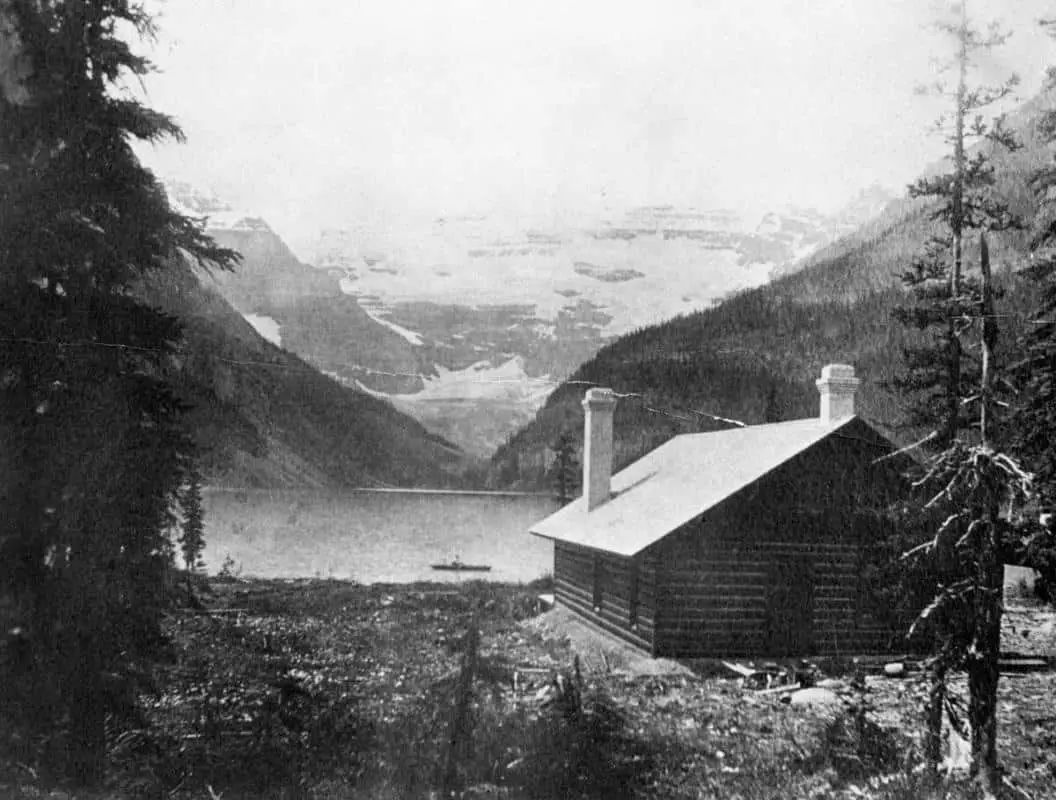The Fairmont Château Lake Louise in Banff National Park has a fascinating history. In this article, we’ll dive into this iconic hotel’s origins, the fires that destroyed it, the rebuilds and the expansions to its current size.
I remember seeing the Fairmont Château Lake Louise for the first time back in 2002. It shocked me. Such a gorgeous lake, spoilt with a giant, not-so-pretty hotel at its northern shore. I regarded it as a giant human disturbance of the lake and the surrounding wilderness. I feel that way to this day.
The explanation of the hotel’s presence at the lake is straightforward: It’s the result of mass tourism. And yes, I am part of it myself. I lived in Banff, I come back regularly and write posts about the park for this website. In a way, I’m enhancing tourism to the park by doing so. Oh, the irony.
There’s a beautiful side to human presence in the park, however. When diving into the hotel’s history for Park Pilgrim, I dug up a fascinating story about ambition, adversity and perseverance that’s worth telling.
The ‘Discovery’ of Lake Louise
When man laid eyes on Lake Louise for the first time is not known. We only know that the Stoney Nakoda and maybe the Blackfoot people visited it well before the first officially recorded visit.
Which was in 1882 when Tom Wilson and Johnson Stevenson stumbled upon the lake that summer. They were packers for the Canadian Pacific Railroad (CPR) and traveled west with a string of horses, transporting supplies into the mountains along the projected railroad trajectory.
On their way back from their second packing expedition through the Kicking Horse Pass, they camped out with a group of Stoney people at the junction of the Bow and Pipestone Rivers. A Stoney explained that a distant rumbling noise was the sound of an avalanche close to the “lake of the small fishes”, or Ho-Run-Num-Nay in Stoney.
The next day, Wilson, familiar with some Stoney words, asked if they could take them to the lake. So they did, and Wilson called the lake Emerald Lake. That’s how Stevenson and he became the first non-native people to lay eyes on the lake.
The Railway Arrives
About one and a half years after Wilson’s discovery, in November 1883, the railroad through western Canada had advanced to the location of the present-day village of Lake Louise. Quickly constructed houses and other structures appeared in the valley north of the lake.
The new settlement hadn’t received formal recognition but got known as Holt City, named after CPR engineer Tom Holt, who opened a general shop at the camp in the winter of 1883/1884.
That winter, in early 1884, the Geographical Society of Canada officially renamed Emerald Lake to Lake Louise in honor of Princess Louise Caroline Albert. She was the fourth daughter of Queen Victoria and wife of Sir John Campbell, Marquis of Lorne, who served as the Governor General of Canada between 1878 and 1883.
That same year, Holt City was renamed Laggan, after the town of the same name in Inverness, Scotland (Laggan is Scottish for “low place”). Lord Strathcona (Donald Smith) of Scotland, co-founder of the CPR, had suggested the name.
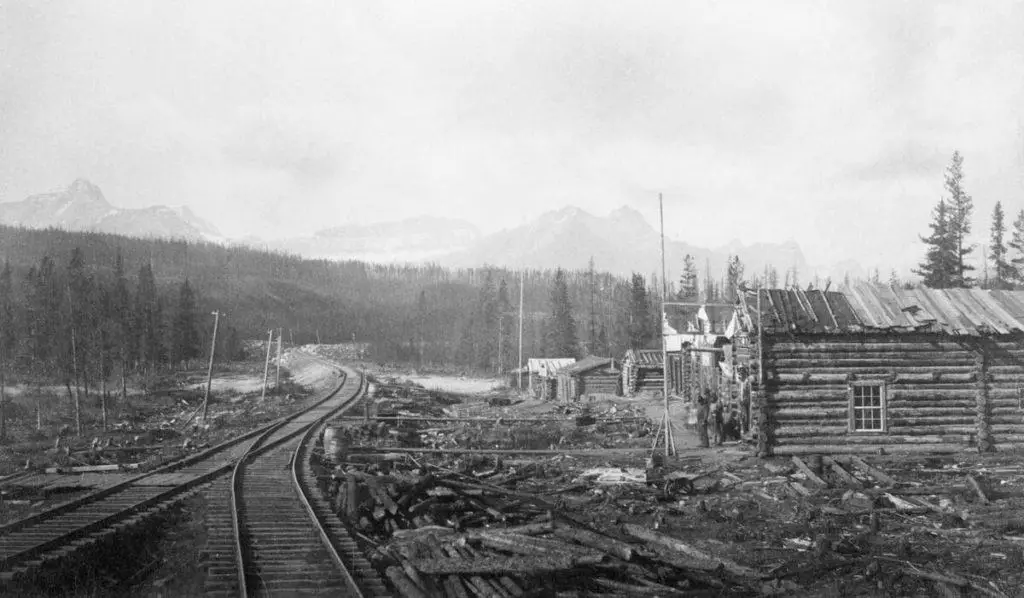
In 1885 Banff National Park, at that time still called Rocky Mountain Park, was opened. However, Laggan wasn’t yet accessible to tourists. (CU181642) by Buell, O. B.. Courtesy of Libraries and Cultural Resources Digital Collections, University of Calgary.
In 1887, Tom Wilson blazed a trail through the forest to the lake. Soon after, a log shelter appeared at the lake shore, used by CPR workers who visited the lake to fish. When the Laggan Train Station was completed in 1890, the first tourists, day trippers from Banff, started to visit the area.
The Canadian Pacific Railway was keen to bring tourism to the park. On the initiative of CPR’s president Cornelius Van Horne, the first hotels were built to finance the railroad construction. Van Horne recognized Lake Louise’s potential and envisioned “a hotel for outdoor adventurers and alpinists”.
With tourism cautiously taking off, CPR asked Willoughby John Astley in 1890 to build a chalet on the edge of Lake Louise (see photo at the top of this post). He had experience constructing this type of building, having built the Beach House Hotel at Minnewanka Landing three years earlier.
The chalet, built just north of the current-day hotel, was a simple log cabin with two bedrooms, a central area that served as a bar, office and dining room, a kitchen and a veranda. Its measurements were a modest 15 x 9 meters (50 x 30 ft). Van Horne called it “Châlet Lake Louise” and appointed Astley as manager.
The few day-tripper tourists visiting the lake came to have an afternoon tea on the veranda. For the first two years, the chalet welcomed less than one hundred guests.
Disaster Strikes
In 1893, disaster struck. On June 19, a fire destroyed the chalet. It was believed sparks from the fireplace caused the fire. A year later, stimulated by emerging tourism, the construction of a new facility began.
Due to the severe weather along the lake’s edge, it was built further back. The new structure was a little larger, with room for twelve people. It measured 12 x 15 meters (40 x 50 ft). A kitchen and two guest rooms were added to the back of the building, and a sizable sitting room with a lake view was built on the main floor. On the second floor, six more bedrooms were realized. The new chalet’s capacity was 20 guests.
As the flow of tourists slowly increased over the years, the new chalet eventually proved too small. In 1898, a second floor was added to the chalet, containing more guest rooms.
Despite the increased capacity, the guests still outnumbered the available beds. So the CPR set up tents along the lakeshore as a short-term solution to the ever-increasing demand.
Meanwhile, Jean Mollison had succeeded Astley in 1895 as the chalet’s manager. The Scottish Mollison, a former housemaid at the Banff Springs Hotel in Banff, was only 21 years old when she started working at Lake Louise. She planted poppies at the lake, which adorn the lakeshore to this day.
Expansion
By 1899, one year after the newest expansion to the chalet, it was expanded yet again. T.C. Sorby, a CPR architect, was hired to replicate the Mount Stephen House, a hotel in the adjacent British Columbian town of Field, which he also designed. He added two wings to the chalet and a large veranda along the lakeside front.
Wanna know about other historical figures in the history of Banff National Park? Read the post Banff’s Most Influential People: The Ones You Need to Know.
Three years later, a boathouse at the shoreline increased the chalet’s facilities. Cows were brought to the lake to provide guests with fresh milk. By now, Lake Louise had been incorporated into Rocky Mountains Park, and the influx of tourists kept increasing. This prompted CPR’s management to plan a much larger hotel at the lake.
The Construction of a Much Larger Hotel
Architect Francis Mawson Rattenbury, who had gained recognition for his designs of the Fairmont Empress Hotel and the BC Parliament Buildings in Victoria, British Columbia, replaced Sorby. He significantly extended the hotel, adding many additional guest rooms with lake views. To fit in the hotel with the surrounding forest, he incorporated a lot of wood in his design.
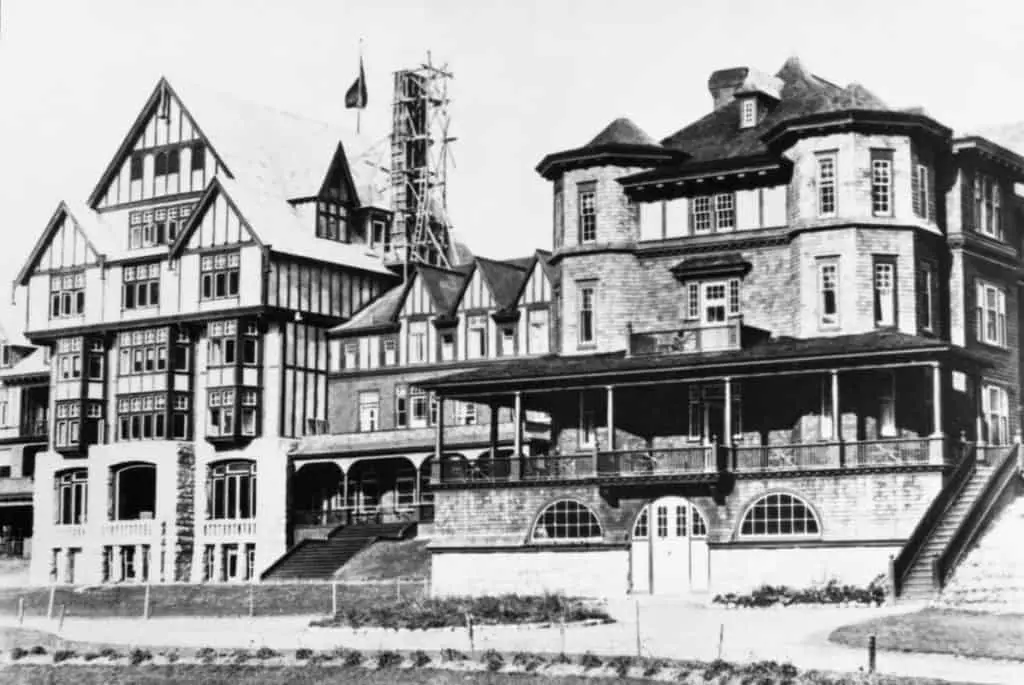
The extension’s construction began in 1902 and took ten years to complete (through 1911). The old chalet was converted into a sitting area with a massive stone fireplace, large windows, and a veranda overlooking the lake. Upon completion, the hotel contained 120 rooms, increasing its capacity to more than 240 guests.
The Painter Wing
While the hotel’s construction was ultimately completed upon Rattenbury’s design, he had left CPR five years earlier. Walter Painter, the man who designed the iconic Banff Springs Hotel, handled the subsequent addition. Construction began in 1912, just one year after the previous expansion was completed. It involved adding a five-story annex to the existing chalet’s north end.
Unlike the earlier wooden construction, the newer portion of the chalet, called the Painter Wing, had a concrete facade and contained two concrete towers. Large arched windows on the ground floor for the new Victoria Dining Room faced the lake. It also included a ballroom. With four new floors above it, the hotel totaled 320 guest rooms.
Now a sizable hotel, the first staff accommodation was built up the hill at the back of the hotel. With 50,000 annual visitors, tourism around the lake was flourishing,.
In 1913, a 50-passenger, 4.5 kilometers (2.8 mi) long tramway was constructed to connect the new Lake Louise train station with the hotel. It marked the end of the 90-minute horse-drawn carriage ride from the train station to the lake.
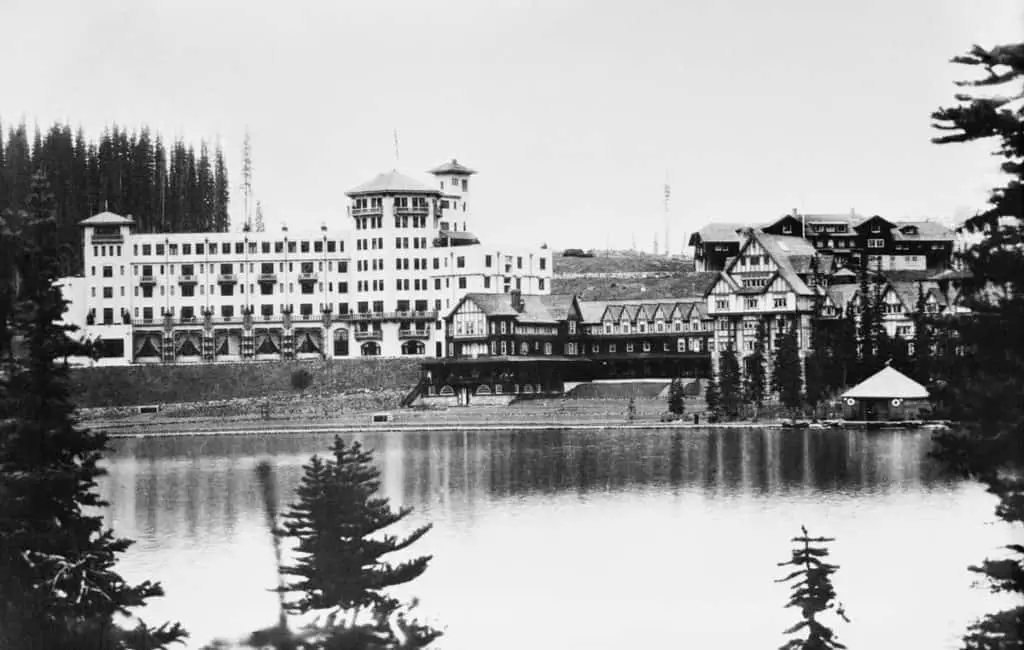
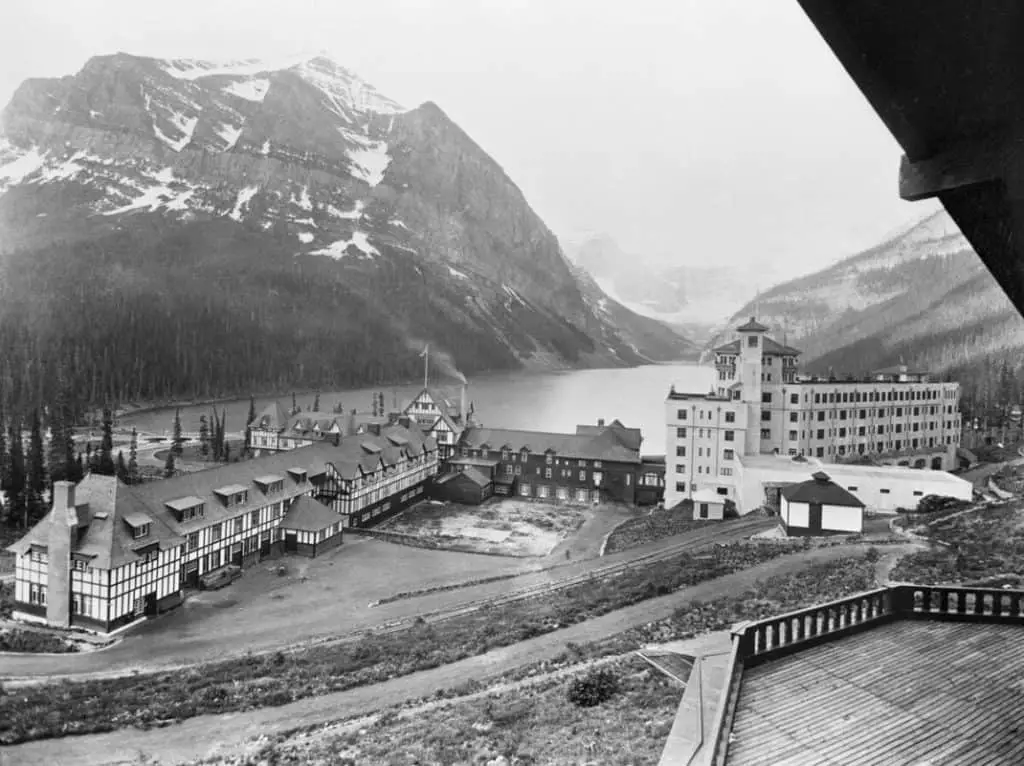
The tramway ultimately also proved temporary due to the opening of a road from the village to the lake. This happened on June 15, 1921, and rendered the tram obsolete. In 1931, the rail line was removed, and the rail bed was turned into a hiking route.
The Second Fire
After years of prosperity, the rebuilt lodge also fell victim to fire. On July 3, 1924, the wooden Rattenbury section was destroyed. The concrete wing, however, survived. And miraculously, no one got injured. It later turned out that the fire had started in the kitchen of the hotel’s staff quarters.
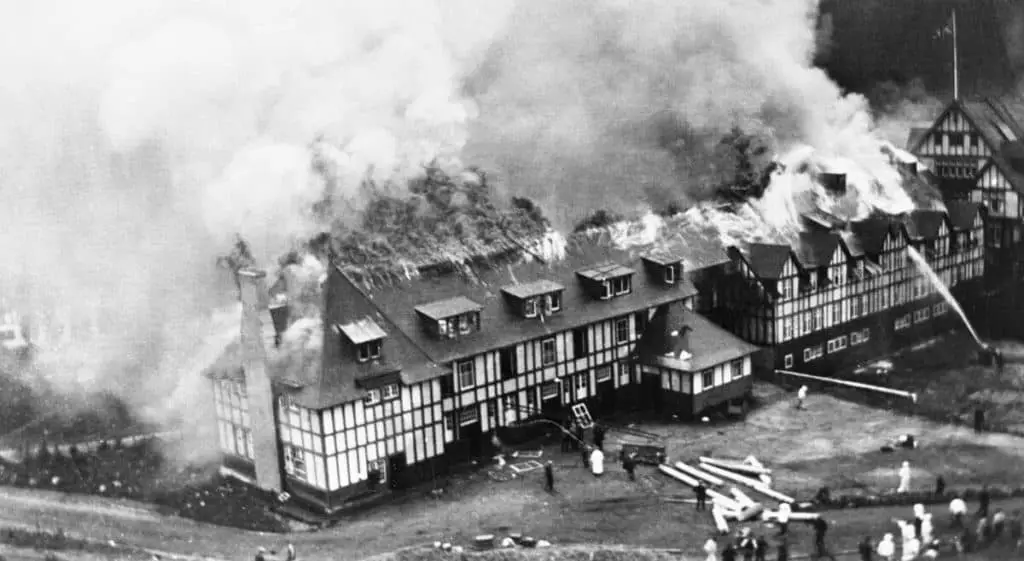
With the continued flow of tourists, rebuilding the Rattenbury wing already started in early September. Painter had designed an 8-story Italian-style attachment, and construction work lasted all winter. The new unit was completed in May 1925.
Name Change
The hotel now had 386 guest rooms, several dining rooms and shops, and 400 employees. Upon completion of the new wing, the hotel’s name was changed from Lake Louise Chalet to Château Lake Louise. One year later, an outdoor pool was constructed between the hotel and the lake.
With facilities at the hotel more luxurious and extensive than ever, celebrities, politicians and royalty started to visit the château, cementing the hotel’s reputation as a top resort.
In 1940, the original road between Banff and Lake Louise was paved, further increasing the accessibility of the lake and the hotel. But due to World War II, European tourists stayed away, and the CPR decided in 1942 that the Château Lake Louise would close until the war ended.
Skiing Facilities in Lake Louise
After the war, the development of skiing facilities, which had already started in the 1930s, accelerated on the initiative of Norman Watson, a major shareholder of the Ski Club of the Canadian Rockies.
In 1952, a 160-meters (500 ft) long surface lift was built up Larch Mountain from Mount Temple Chalet. Two years later, a permanent Poma lift was erected. In 1957, a gondola was built on Mount Whitehorn’s summit and in 1972, the Eagle chairlift on Larch Mountain.
Over the years, several hotels were built in the Lake Louise area, and the skiing facilities made it a year-round tourist destination. That resulted in Château Lake Louise opening to winter visitors for the first time in 1974. And in 1982 it opened for its first entire winter season.
More New Additions
During this time, the outdoor pool was closed, and an indoor pool took its place. The Tom Wilson dining room, a brand-new rooftop restaurant on the original Painter Wing, opened at the hotel in the spring of 1983.
The 1980s demonstrated that the hotel required yet another expansion due to the steadily rising number of tourists. As a result, work on the Glacier Wing, which had already been considered in the 1920s, began in 1987.
The goal of the design by Calgary-based Carruthers and Associates was to integrate the new wing into the old section. It added another 140 guest rooms to the hotel, and it also included additional restaurants, a lounge, a shopping promenade, and a new lobby.
By now, Château Lake Louise had become a giant hotel that dominated the northern lakeshore. In 1999, Canadian Pacific Hotels, a division of Canadian Pacific Railway, purchased Fairmont Hotels & Resorts, and from 2001, Château Lake Louise was operated as a Fairmont hotel.
The Last Expansion
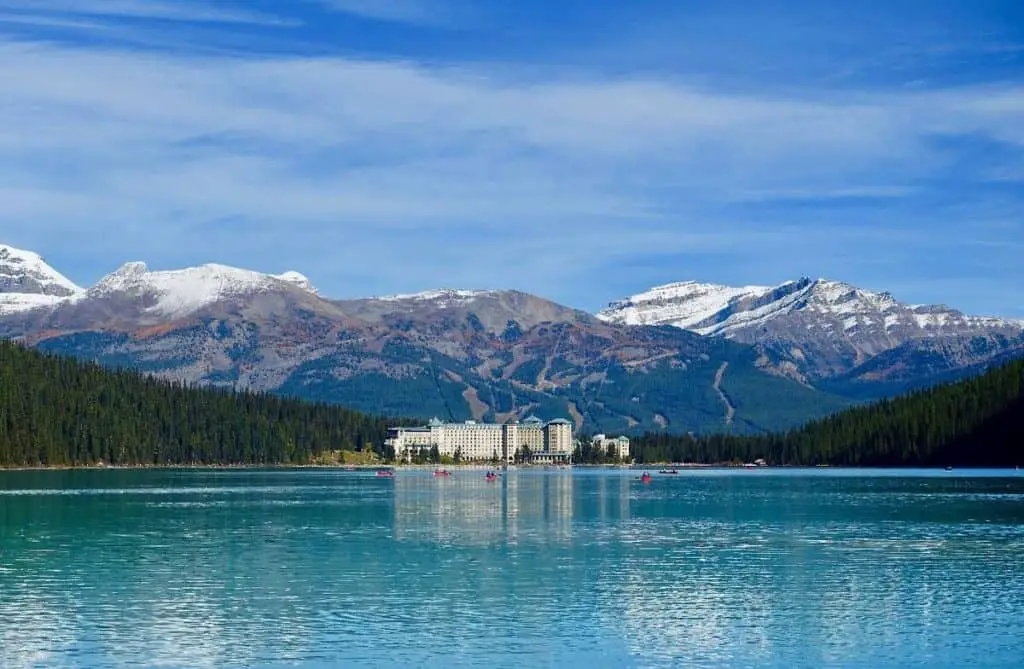
Despite its massive size, the hotel still wasn’t big enough, as became apparent over the years. As a result, another extension was added to the hotel. In June 2004, the Mount Temple Wing was completed.
It continued along the hotel’s back, which increased the number of guest rooms to 550. However, most of the facility was used for conferences, meetings and conventions.
To this day, the Château Lake Louise makes up almost half of all available hotel rooms in Lake Louise. It’s more popular than ever, resulting in high occupancy rates. Maybe yet another addition to the hotel will be constructed in the near future, who knows?
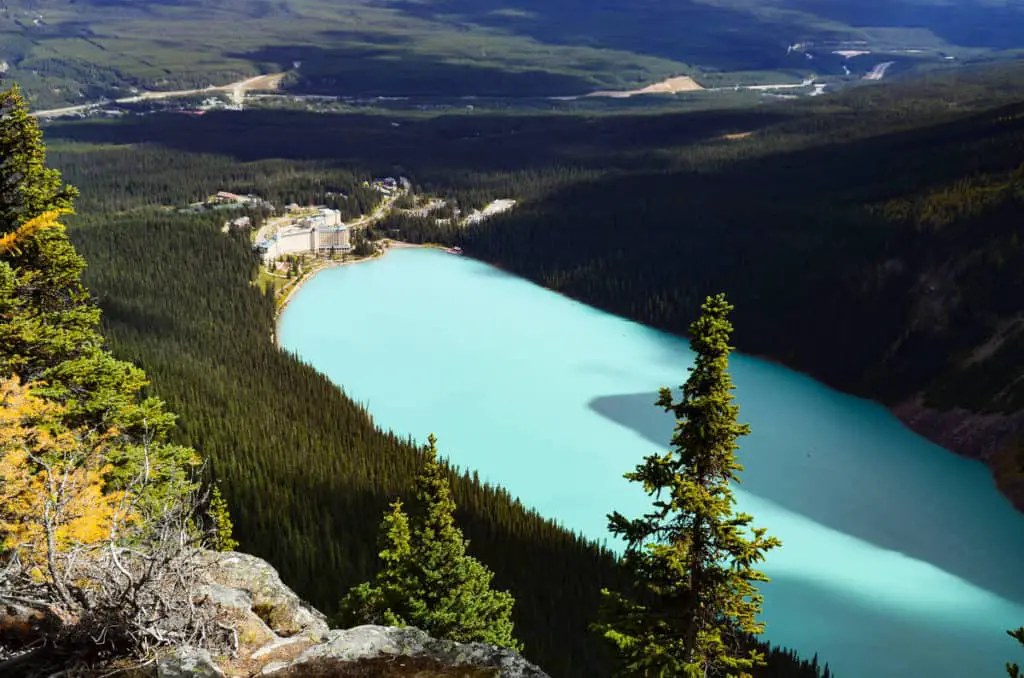
Timeline
Below you’ll find a timeline with all highlights in the hotel’s history.
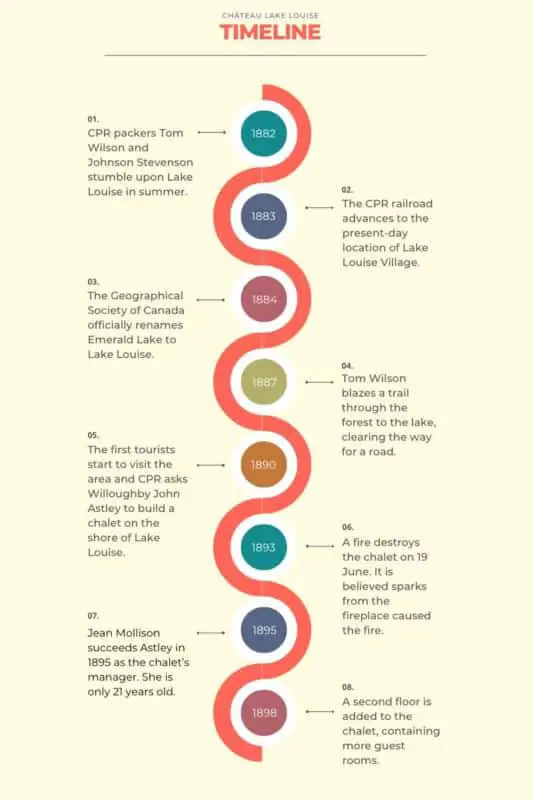
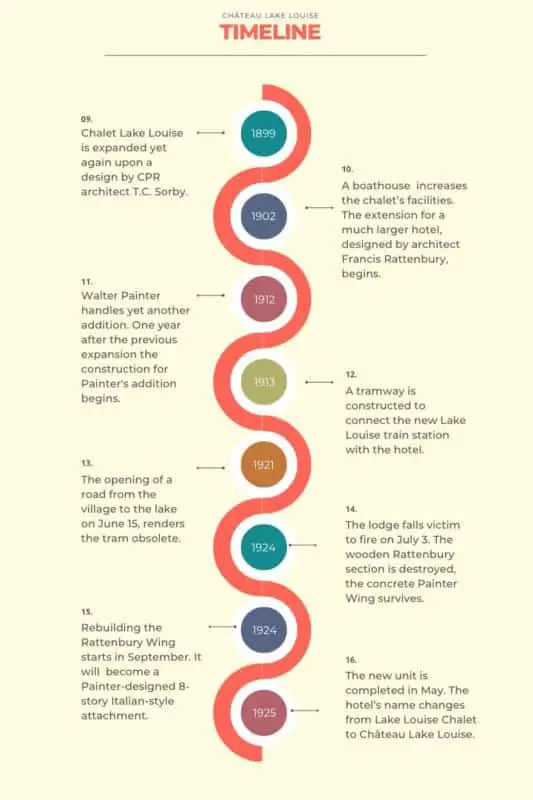
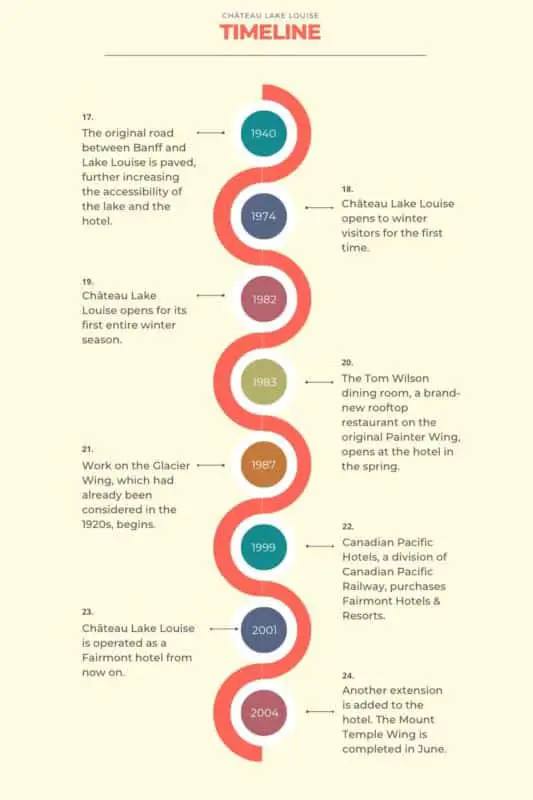
Want to read more about the history about the other big resort hotel of Banff National Park? Read the post The Fascinating History of the Banff Springs Hotel.
Selected Sources
- Banff, Canada’s First National Park, Eleanor G. Luxton, 1974, Summerthought Publishing
- Lake Louise Past to Present, Andrew Hampstead, 2016, Summerthought Publishing
- Banff & Lake Louise History Explorer, Ernie Lakusta, 2004, Altitude Publishing

